Many people with diabetes suffer from their feet. This is also called a diabetic foot. It can result in chronic wounds and in the worst case even amputation. In short, it is not something to be underestimated. But why do diabetics specifically suffer from foot problems and what can be done about it? Read it below.
Symptoms
A numbing or tingling feeling occurs in the feet (as if you were walking on cotton wool). Feet may also feel cold. You feel less blisters. You may also discover too late that your feet are too tight in the shoes. Sweat glands also work less well, making the skin drier and thinner. This causes wounds and fungal infections. Wounds can turn into an ulcer, too ulcer named. These are also more difficult to heal due to the damaged blood vessels that diabetics suffer from. It is even possible that small fractures occur because you develop an unstable walking pattern. This is also called a Charcot foot. Due to the abnormal foot position, your foot will look red and swollen. Walking will become more difficult. Fortunately, a Charcot foot is not common.
Cause of diabetic feet
Diabetics can regularly have to deal with high blood sugar levels. The body is unable to remove excess sugar from the blood, resulting in blood vessels being damaged. This restricts blood flow to the nerves. Tissues do not receive enough oxygen and nerve damage can occur. As a result, signals are no longer properly transmitted between the brain on the one hand and the muscles, internal organs and skin on the other. And this is often quickly noticeable on the feet.
Prevent complications with feet
Not everyone with a diabetic foot will develop ulcers, but the risk is much greater than in people who do not have diabetes. It is very important for diabetes patients to keep blood sugar levels in balance. In addition, it is advisable to regularly check the feet for irregularities, such as discolorations, wounds and deformations. Using a mirror is useful for checking the bottom of the foot. Nails should be cut straight across. They should also not be cut too short. Foot baths are better avoided. Furthermore, it is not recommended to walk barefoot. This prevents you from stepping into something sharp without feeling it. You also limit the risk of infections in existing wounds. But poorly fitting shoes and seams on socks can also cause wounds. When wearing shoes you should avoid pinching and pressure points. Good footwear is therefore extra important for diabetes patients. Some people have an increased risk of foot problems. For example, by smoking, by practicing poor foot hygiene or by health problems from the past.
Therapy
Make an appointment with the doctor or hospital if wounds do not heal quickly. Timely treatment is essential for healing diabetic foot wounds. If a wound is left untreated for a long time, it can ultimately result in amputation of a toe, foot or leg. Several specialists are often used for the treatment, such as an internist, dermatologist and vascular surgeon. Depending on the foot problems, a specific treatment is chosen. This includes, for example, removing calluses, treating existing wounds with antibiotics, fitting support stockings and orthopedic shoes and providing information. Sometimes a special procedure is necessary. For example, to improve blood circulation or to remove an infection. Hyperbaric oxygen therapy can also be used. You then breathe in 100% oxygen, so that the feet receive sufficient oxygen again.

